Understanding vaccination schedules and booster protocols helps you protect yourself and your community. Proper timing ensures vaccines build strong immunity, while booster shots reinforce this protection over time. Achieving herd immunity depends on high vaccination rates, reducing disease spread. As new variants emerge, schedules may adapt to maintain effectiveness. Staying informed about these strategies can boost your confidence in immunizations and their vital role in community health—if you want to explore more, there’s plenty to learn.
Key Takeaways
- Vaccination schedules are designed to optimize immunity and include booster doses to reinforce long-term protection.
- Achieving herd immunity requires high vaccination coverage and proper timing of initial and booster doses.
- Booster shots are administered at specific intervals (e.g., around 12 months) to maintain antibody levels and immune memory.
- Correct scheduling prevents waning immunity, reduces transmission, and helps protect vulnerable populations.
- Monitoring variants and immune responses guides schedule adjustments, ensuring continued herd immunity effectiveness.
Understanding the Basics of Vaccination Schedules

Have you ever wondered how vaccination schedules are planned? It all starts with understanding the basics. Proper vaccine storage is essential to guarantee vaccines remain effective until administration. Health experts carefully determine when each vaccine should be given to optimize immunity and minimize side effects. Public awareness plays a critical role in this process, as educating communities about vaccination timing encourages participation and compliance. Schedules are designed based on age, health status, and risk factors, making certain each individual receives the right vaccines at the right time. Clear communication about these schedules helps prevent confusion and boosts vaccination rates. By maintaining proper vaccine storage and raising public awareness, health systems can effectively implement vaccination schedules that protect entire communities.
How Vaccines Build Immunity Over Time
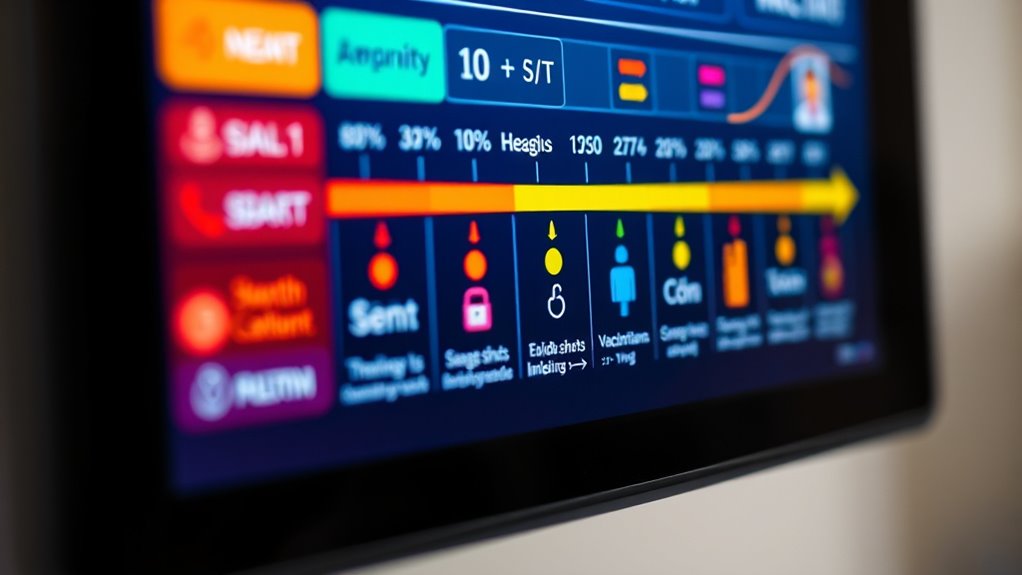
When you receive a vaccine, your immune system begins to respond by recognizing the harmless parts of the pathogen and developing defenses against it. Over time, this process strengthens your immunity through several steps:
- Your body creates memory cells, enabling faster responses if exposed again.
- Antibodies increase, providing immediate protection against infection.
- Booster doses reinforce immunity, especially as antibody levels decline.
- The Greek Sceptic approach emphasizes understanding the scientific basis of immunity, encouraging informed decision-making about vaccinations.
- Additionally, water-based immune responses can be stimulated through aquatic exercises and hydrotherapy, which support overall health and immune function.
Understanding how vaccines build immunity helps address vaccine hesitancy by emphasizing their effectiveness. Proper cold chain logistics ensure vaccines stay potent during storage and transport, essential for reliable immunity. Maintaining trust in vaccination programs depends on clear communication about how immunity develops over time, highlighting the importance of completing schedules and booster shots. This process ultimately protects not just you but the community through herd immunity.
The Role of Herd Immunity in Public Health
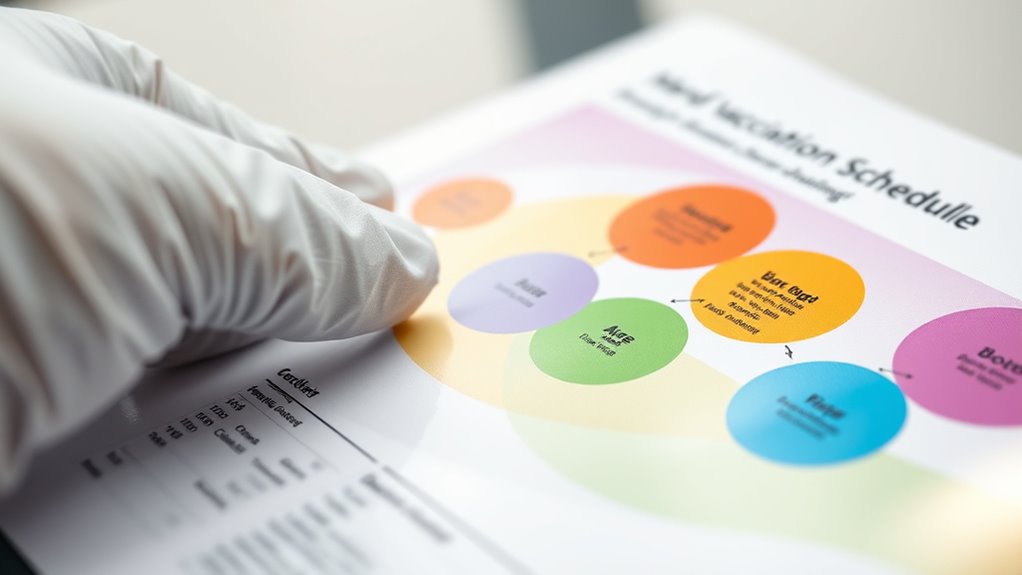
Herd immunity helps protect your community by reducing the spread of contagious diseases. When enough people are vaccinated, it becomes harder for illnesses to transmit, safeguarding those who can’t be vaccinated. Understanding the immunity threshold needed can guide public health efforts to keep everyone safe. Additionally, collaborations with influencers and innovative strategies are crucial for increasing vaccination rates and achieving herd immunity. Engaging in effective communication strategies can also play a vital role in dispelling vaccine misinformation and encouraging higher uptake. Implementing targeted educational campaigns can further enhance public understanding of vaccine benefits and support community immunity goals.
Community Protection Benefits
Ever wondered why widespread vaccination can protect even those who aren’t vaccinated? It’s because of herd immunity, which creates a barrier that limits disease spread. This societal impact benefits everyone, especially vulnerable populations who can’t get vaccinated. To maximize community protection, consider these key points:
- Achieving vaccine equity guarantees vulnerable groups are protected, strengthening overall immunity.
- High vaccination rates reduce the chance of outbreaks, safeguarding public health.
- Collective immunity helps prevent disease resurgence, even if some individuals remain unvaccinated.
- Recognizing the influence of cultural narratives promoted through film and media, such as Bollywood icons, can help improve public health messaging and encourage vaccination acceptance. Promoting vaccine safety and addressing misconceptions through media can further boost vaccination efforts, especially considering the public perception influenced by social factors.
Transmission Reduction Impact
Herd immunity plays a crucial role in reducing disease transmission within communities. When enough people are vaccinated, it creates a barrier that makes it harder for pathogens to spread. This protection benefits even those who can’t be vaccinated, like individuals with certain health conditions. Additionally, a fragile supply chain can disrupt vaccine availability, delaying coverage and weakening herd immunity’s impact. As a result, disease transmission rates may rise, and outbreaks become more likely. You can help strengthen herd immunity by addressing vaccine hesitancy and supporting reliable supply chains, ensuring vaccines reach everyone. Vaccine distribution can influence vaccination funding and access, indirectly affecting community immunity levels. Ensuring the timely delivery of vaccines is essential to maintaining effective herd immunity. Together, these efforts improve community-wide transmission reduction and public health resilience.
Threshold for Immunity
Have you ever wondered how many people need to be vaccinated to effectively prevent the spread of a contagious disease? The threshold for immunity varies but generally depends on the disease’s contagiousness. To achieve herd immunity, you need:
- A high enough vaccination rate—often 70-95%, depending on the disease.
- Overcome vaccine hesitancy that may lower participation.
- Address logistical challenges that hinder vaccine access or distribution.
- Maintaining vaccination coverage is especially important in outdoor environments, where exposure risk can be higher.
If these factors aren’t managed, outbreaks can still occur despite vaccination efforts. Herd immunity protects vulnerable populations who can’t be vaccinated. The goal is to reach that critical threshold where the disease can’t spread easily, but vaccine hesitancy and logistical challenges can make reaching this goal difficult. Staying informed and advocating for accessible vaccination is essential.
Timing and Dosage in Vaccination Campaigns

Timing and dosage are crucial factors that determine the success of vaccination campaigns. Proper scheduling ensures your body has enough time to develop immunity without exposing you unnecessarily to vaccine side effects. Administering doses too early or too late can weaken protection. You should also be mindful of storage requirements; vaccines must be kept at specific temperatures to remain effective, avoiding compromised efficacy that could lead to ineffective protection or unexpected side effects. Accurate timing minimizes adverse reactions and ensures maximum immune response. When doses are correctly spaced, your body can build immunity efficiently while reducing the risk of vaccine side effects. Additionally, understanding the importance of proper storage conditions helps maintain vaccine potency and effectiveness. Proper scheduling also plays a role in herd immunity, which protects the community by reducing disease spread. Maintaining the correct vaccination intervals is essential for optimizing immune response and long-term protection. Adhering to these protocols guarantees the best possible outcome for both individual health and community herd immunity.
The Science Behind Booster Shots
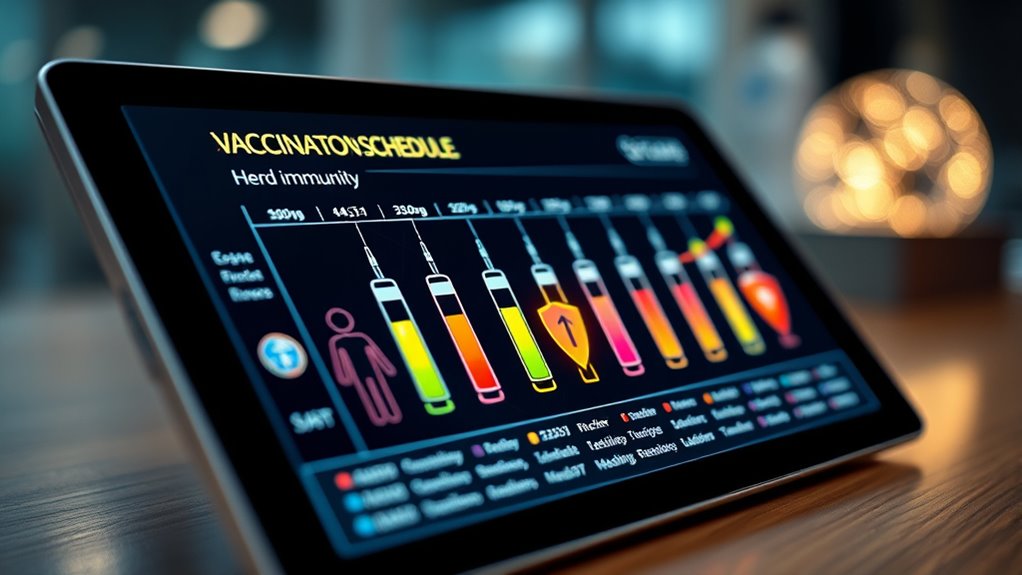
Booster shots play a key role in strengthening your immune response, helping your body recognize and fight diseases more effectively. The timing of these doses is vital to maintain long-term immunity and prevent waning protection. Understanding how boosters enhance immunity ensures you stay protected over time. Additionally, ongoing research into immune system optimization highlights the importance of continuous monitoring and development to address vulnerabilities and ensure trustworthy health information. Recognizing the effectiveness of different vaccine types can further improve booster strategies and public health outcomes.
Immune Response Enhancement
When your immune system encounters a vaccine, it mounts a response by producing antibodies and activating immune cells. To enhance this process, booster shots play a vital role. They help strengthen your immune response through several mechanisms:
- Adjuvant effectiveness: Boosters often include adjuvants that improve the immune system’s recognition of the vaccine, resulting in a more robust response.
- Vaccine storage: Proper vaccine storage ensures the vaccine’s potency remains intact, maximizing immune response upon administration.
- Memory cell development: Boosters stimulate the formation of memory cells, which provide longer-lasting immunity and quicker responses to future exposures. Additionally, ongoing research into cybersecurity vulnerabilities in vaccine distribution systems emphasizes the importance of secure data handling to maintain trust and safety.
- Understanding herd immunity principles can help explain how widespread booster vaccination benefits community health. Many vaccines are designed to produce high suction power and durability, ensuring long-term protection.
Together, these factors optimize your body’s ability to fight off infections, making boosters an essential component of vaccination strategies.
Timing of Boosters
Understanding the ideal timing for booster shots is crucial because it directly impacts the durability and strength of your immune protection. Administering boosters too early might not allow enough time for immunity to wane, while delaying too long could leave you vulnerable. Proper timing ensures maximum vaccine effectiveness and simplifies side effect management. Remember, vaccine storage conditions can affect vaccine potency, so follow storage guidelines closely.
| Timing Option | Benefits | Considerations |
|---|---|---|
| Early (6 months) | Faster immunity boost | Risk of unnecessary side effects |
| Optimal (12 months) | Balanced protection | Requires monitoring immune response |
| Delayed (18+ months) | Extended immunity | Possible reduced effectiveness |
Choosing the right timing maximizes immunity, minimizes side effects, and maintains vaccine efficacy.
Long-term Immunity
Timing your booster shots directly influences how long your immunity lasts. Without timely boosters, your immune response can weaken, making you more vulnerable to infection. To maintain long-term immunity, consider these factors:
- Regularly monitor your healthcare provider’s advice to stay updated on recommended booster intervals.
- Address vaccine hesitancy by understanding that booster shots are safe and help sustain protection, despite concerns about adverse effects.
- Recognize that while some may worry about adverse effects, serious reactions are rare, and the benefits of continued immunity far outweigh the risks.
Adapting Schedules for Emerging Variants

How can vaccination schedules stay effective amid emerging variants? When viruses undergo antigenic drift, their surface proteins change, leading to a potential vaccine mismatch. This means your current vaccines might not fully prevent infection from new variants. To adapt, health authorities may recommend booster shots with updated formulations that target these evolved strains. You might also see shorter intervals between doses or additional boosters to enhance protection. Monitoring circulating variants closely allows for timely adjustments to vaccination schedules, ensuring you stay protected. Staying informed about variant updates helps you understand why schedules may shift. By promptly modifying vaccination strategies, you help maintain herd immunity and reduce the risk of breakthrough infections caused by evolving variants.
Challenges in Maintaining Long-term Immunity
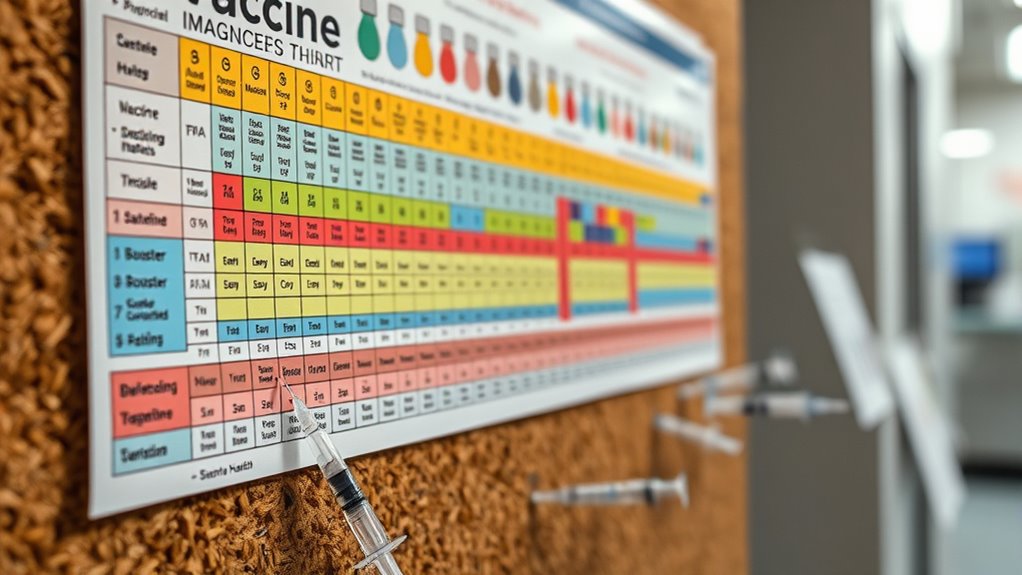
Maintaining long-term immunity through vaccination presents ongoing challenges because your immune response naturally wanes over time. One key issue is antibody durability; over months or years, antibody levels can decrease, reducing protection. Additionally, vaccine hesitancy can hinder efforts to boost immunity across populations, creating gaps in herd immunity. To address these challenges, consider the following:
- Monitoring antibody levels to determine when booster shots are needed.
- Improving vaccine formulations to enhance long-lasting immune responses.
- Engaging communities to combat vaccine hesitancy and promote sustained vaccination efforts.
Strategies for Achieving Optimal Population Coverage
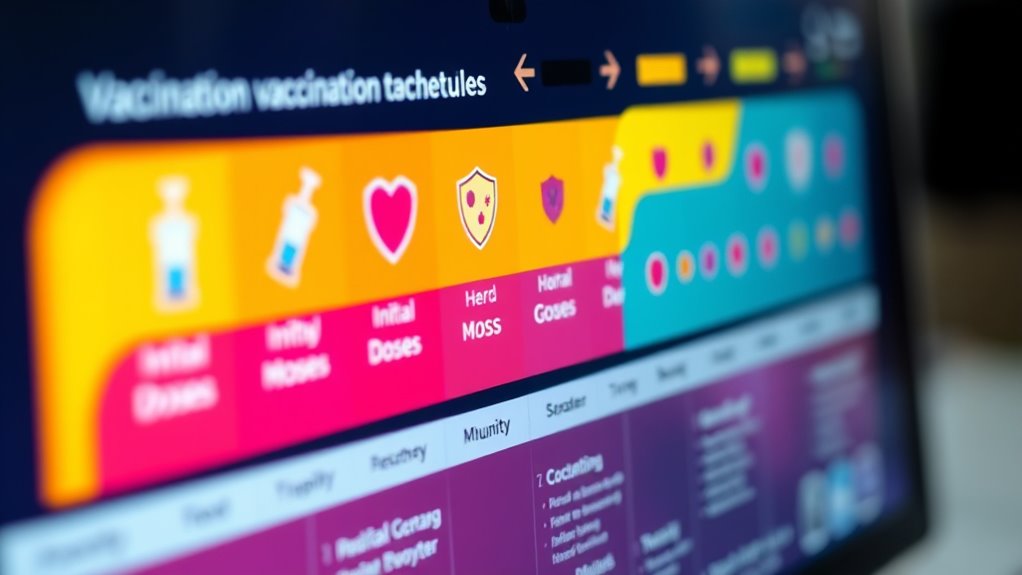
Achieving ideal population coverage requires a strategic combination of targeted outreach, efficient resource allocation, and effective communication. To do this, you must guarantee vaccines are stored properly, maintaining the correct vaccine storage conditions to preserve potency and prevent wastage. Public awareness campaigns play a crucial role in informing communities about vaccination benefits and schedules, building trust, and addressing hesitations. Outreach efforts should focus on vulnerable groups and areas with low coverage, making vaccines accessible and convenient. Clear messaging about the importance of vaccination helps overcome misconceptions. By coordinating logistics, optimizing vaccine storage, and raising public awareness, you can increase vaccination rates, move closer to herd immunity, and protect the entire population from preventable diseases.
Future Directions in Vaccination Planning

Looking ahead, vaccination planning is poised to benefit from technological advancements and innovative strategies that can enhance efficiency and reach. To address challenges like vaccine hesitancy and improve public awareness, future efforts may include:
Future vaccination strategies will leverage technology to improve reach, build trust, and address hesitancy effectively.
- Developing digital platforms for real-time data analysis, enabling targeted outreach and better resource allocation.
- Leveraging social media and mobile apps to combat misinformation and promote vaccine benefits directly to communities.
- Implementing personalized communication strategies that address specific concerns, fostering trust and encouraging vaccination.
These approaches aim to increase vaccination rates, reduce hesitancy, and guarantee more equitable access. Embracing new technologies and strategies will be vital in creating adaptable, responsive vaccination plans that meet evolving public health needs.
Frequently Asked Questions
How Do Vaccine Schedules Vary Across Different Age Groups?
You’ll notice vaccine schedules vary across age groups because health authorities create age-specific recommendations based on developmental considerations. For infants, vaccines focus on early protection, while older children and teenagers receive additional shots to boost immunity as their bodies grow. Adults and seniors may follow different schedules to address changing health risks. This tailored approach ensures each age group gets ideal protection aligned with their unique immune system needs.
What Factors Influence the Timing of Booster Shots?
Think of booster shots as catch-up calls to your immune system’s best friend. Your healthcare provider considers vaccine efficacy and your immune response to decide their timing. Factors like age, health status, and how long immunity lasts play roles, ensuring your defenses stay strong. By understanding these elements, you help your body stay prepared, like a fortress ready to ward off future invaders.
How Do New Variants Impact Current Vaccination Strategies?
When new variants emerge, it critically impacts your vaccination strategies. Variant emergence can reduce vaccine effectiveness, prompting health authorities to contemplate vaccine adaptation to better target the evolving virus. You might see updated vaccines or booster recommendations to guarantee continued protection. Staying informed about these developments helps you understand why vaccination schedules might change, as adapting to new variants is essential for maintaining immunity and controlling the spread of illness.
Are There Differences in Herd Immunity Thresholds Globally?
While herd immunity thresholds vary worldwide, the goal remains the same: protect communities from disease spread. You should know that differences in global immunity stem from factors like vaccination rates, healthcare infrastructure, and population density. Some regions need higher herd thresholds, especially with new variants emerging. These disparities highlight the importance of tailored strategies to reach herd immunity, ensuring everyone benefits from collective protection regardless of where they live.
How Does Individual Health Status Affect Vaccination Timing?
Your individual health status influences vaccination timing because your immune response varies. If you have chronic conditions, your immune system might respond less effectively, so healthcare providers may recommend additional doses or adjusted schedules. Staying informed and consulting your doctor helps guarantee you get the best protection, especially if your immune response is compromised. Tailoring vaccination timing helps optimize immunity and safeguard your health based on your specific health circumstances.
Conclusion
By understanding vaccination schedules, you play a essential role in safeguarding your community. Herd immunity acts like an unbreakable shield, but it needs your participation through timely boosters and adherence to schedules. Remember, each shot isn’t just for you—it’s for everyone around you. So, stay informed, get vaccinated, and help turn the tide against emerging threats. Together, your actions can write a future where immunity isn’t just a hope, but a certainty.









